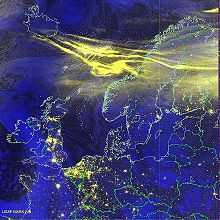Geomagnetic Storms from Halloween 2003
The geomagnetic storms of Halloween 2003 were caused by several solar flares and coronal mass ejections that took place on the solar surface from mid-October to early November 2003 and peaked on October 28th to 29th. They fell on solar cycle 23 , about three years after it peaked. This series of storms was the largest series of solar flares ever recorded by the GOES system . Radio wave-based measurements showed an exposure to X-rays of X45 on the Earth's upper atmosphere, they initially had been estimated at X28. X corresponds to the top class in the classification of solar flares and X45 corresponds to an X-ray intensity of 4500 µW / m² on this scale. The highest stress previously measured with a value of X20 was reached on April 2, 2001 and August 16, 1989. The "Geomagnetic Storms Halloween 2003" are compared to the geomagnetic storms of 1859, the Carrington event .
Effects
Satellite-based systems and communication systems were affected by the effects of coronal mass ejections; Aircraft were instructed to avoid high altitudes near the polar regions. The astronauts of the International Space Station were instructed to stay in the better shielded part of the Russian orbital segment so that they were protected from the increased radiation levels.
In Malmö and other parts of southern Sweden there was a power outage due to solar activity, which was triggered by the failure of a transformer, similar to 1989 in Québec , the power outage lasted about an hour. Northern lights could be seen as far as Mediterranean countries and North America as far as Florida. There have also been numerous sightings of bright northern lights in German-speaking countries. Northern lights were also seen at the South Pole, and several transformers were destroyed in South Africa.
The Solar and Heliospheric Observatory spacecraft temporarily failed, and the Advanced Composition Explorer was damaged by solar activity. Other spacecraft were damaged or temporarily failed. Some had previously been placed in Safe Mode to protect equipment.
A few hours later, the space probe 2001 Mars Odyssey registered the effects of the coronal mass ejection on the thin atmosphere of Mars , which was partially shredded and released into space. The Ulysses space probe registered the mass ejection near Jupiter and Cassini-Huygens near Saturn . Here the influence was still strong enough to cause considerable effects on the atmosphere of Saturn, although this has a much larger magnetic field than the earth. Voyager 2 captured the eruption in April 2004.
Web links
Individual evidence
- ↑ Richard D. Rosen: Intense Space Weather Storms October 19 - November 07, 2003. (PDF) Service Assessment. US Department of Commerce, National Weather Service, April 2004, accessed October 29, 2018 .
- ↑ Solar cycle 23. In: meteo.plus. tempsvrai.com, Nierstein, accessed on October 25, 2018 .
- ^ NR Thomson, CJ Rodger, RL Dowden: Ionosphere gives size of greatest solar flare . In: Geophysical Research Letters . AGU100. tape 31 , no. 6 , March 17, 2004, doi : 10.1029 / 2003GL019345 ( wiley.com [accessed October 29, 2018]).
- ↑ Biggest ever solar flare was even bigger than thought. In: spaceref.com. American Geophysical Union, accessed October 25, 2018 .
- ↑ a b Michael Weaver et al .: Halloween Space Weather Storms of 2003. (PDF) NOAA Technical Memorandum OAR SEC-8. US Department of Commerce, National Oceanic and Atmospheric Administration, June 2004, archived from the original on July 28, 2011 ; accessed on October 29, 2018 .
- ↑ a b Eric Levin: 86: 2003 Halloween Storms Still Rock Solar System . In: Discover Magazine . January 2, 2005 ( discovermagazine.com [accessed October 29, 2018]).
- ↑ M. Wik, R. Pirjola, H. Lundstedt, A. Viljanen, P. Wintoft, A. Pulkkinen: Space weather events in July 1982 and October 2003 and the effects of geomagnetically induced currents on Swedish technical systems . In: Annales Geophysicae . tape 27 , no. 4 , April 14, 2009, ISSN 0992-7689 , p. 1775–1787 , doi : 10.5194 / angeo-27-1775-2009 ( ann-geophys.net [accessed October 29, 2018]).
- ^ Andreas Möller: Polar light archive for Germany. Retrieved November 15, 2018 .
- ^ A b Holly Zell: Halloween Storms of 2003 Still the Scariest. In: SOHO (Solar and Heliospheric Observatory). NASA, October 27, 2008, accessed October 29, 2018 .
- ↑ Anke Wilde: The danger from solar storms for our technology. Space weather. Der Tagesspiegel, August 1, 2016, accessed on October 29, 2018 .
